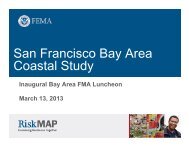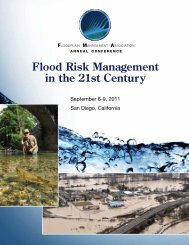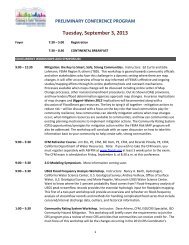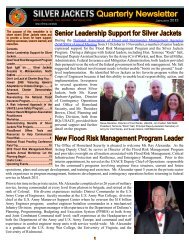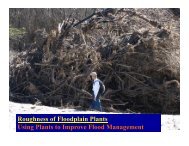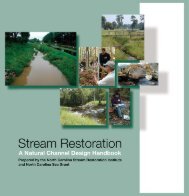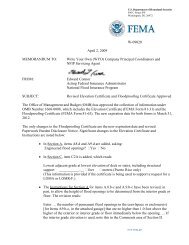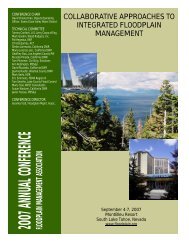Using Multi-Objective Management to Reduce Flood Losses in Your
Using Multi-Objective Management to Reduce Flood Losses in Your
Using Multi-Objective Management to Reduce Flood Losses in Your
You also want an ePaper? Increase the reach of your titles
YUMPU automatically turns print PDFs into web optimized ePapers that Google loves.
Chapter 2<br />
Understand<strong>in</strong>g <strong>Your</strong> Watershed<br />
There are many types of flood problems. You could have overbank flood<strong>in</strong>g from<br />
large rivers, coastal flood<strong>in</strong>g dur<strong>in</strong>g s<strong>to</strong>rms and hurricanes, flash flood<strong>in</strong>g on<br />
small streams, basement flood<strong>in</strong>g from sewer backups, or a comb<strong>in</strong>ation of those.<br />
The first step <strong>in</strong> tackl<strong>in</strong>g your flood problem is understand<strong>in</strong>g what causes it.<br />
To beg<strong>in</strong>, it is important <strong>to</strong> note that flood<strong>in</strong>g is a natural occurrence.<br />
Rivers, lakes, and salt-water bodies have always overflowed their normal beds <strong>to</strong><br />
<strong>in</strong>undate the nearby land. The land adjacent <strong>to</strong> these bodies of water is called the<br />
floodpla<strong>in</strong>.<br />
<strong>Flood</strong>pla<strong>in</strong> lands look dry most of the time, but nature <strong>in</strong>tends that they be<br />
covered with water periodically. As long as we can live with this, there will be no<br />
problems. <strong>Flood</strong> problems arise when we <strong>in</strong>terfere with the natural process of<br />
river<strong>in</strong>e, coastal, and other types of flood<strong>in</strong>g.<br />
River<strong>in</strong>e <strong>Flood</strong><strong>in</strong>g<br />
River<strong>in</strong>e flood<strong>in</strong>g simply means flood<strong>in</strong>g of a river, stream, or other channel. To<br />
understand river<strong>in</strong>e flood<strong>in</strong>g, you need <strong>to</strong> be aware of your watershed.<br />
The watershed<br />
A watershed is the area that dra<strong>in</strong>s <strong>to</strong> a lake, stream, or other body of water. It is<br />
also called a bas<strong>in</strong> or catchment area.<br />
The boundary of a watershed is a ridge or divide. The divide is the high<br />
ground and the river or lake is the lowest ground. Ra<strong>in</strong> and snowmelt flow from<br />
the divide <strong>to</strong> the receiv<strong>in</strong>g stream.<br />
A WATERSHED BOUNDARY<br />
5



